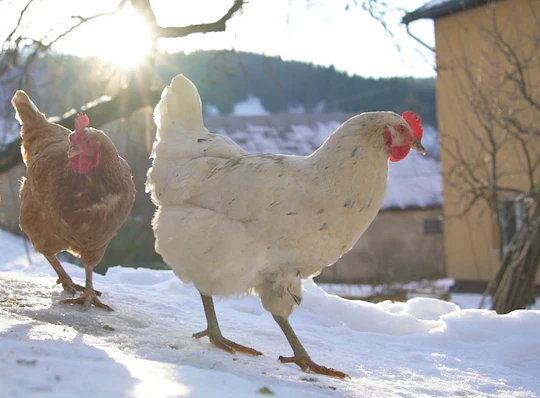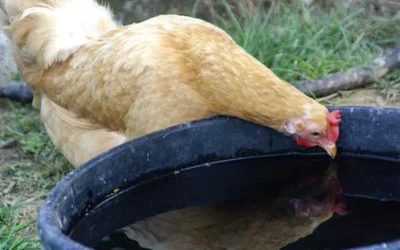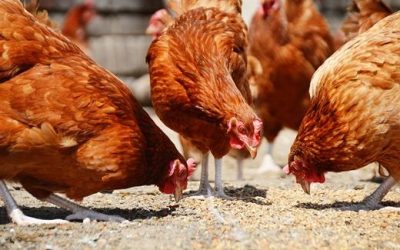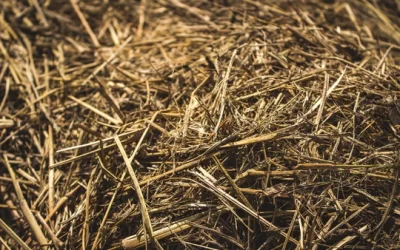Did you know that chickens can get frostbite? While most chicken breeds adapt well to the cold, when winter brings cold, wet, snowy weather, your flock may be more susceptible to developing frostbite. A flock’s susceptibility to frostbite is largely determined by their breed, the housing structures, and environment that is available to your flock. Avoid and prevent frostbite in your flock by understanding it and the conditions that make it possible.
What Is Frostbite?
Frostbite occurs when extremely cold, windy, and damp weather conditions cause blood-flow to redirect to the vital organs in order to keep them warm. As a result, the extremities receive less blood flow and the fluid beneath the skin becomes more vulnerable to freeze. This results in cell damage and an eventual darkening of the affected area as tissue death occurs. Luckily, frostbite develops in stages, and knowing what to look for can help you better protect your flock.
How to Spot Early Signs of Frostbite
When frostbite first starts to happen within your flock, it is not always obvious. The parts of your chickens that are most susceptible to frostbite are the parts that are most exposed to the elements. These include the comb, wattles, and the feet. Here is what to look for:
Stage 1: Your chickens’ skin may appear slightly reddened and be cold to the touch.
Stage 2: Further color changes to tissues occur such as lightening, whitening, and paleness.
Stage 3: Affected tissues may feel cold or hard to the touch, become numb, and show signs of muscle stiffness.
Stage 4: Blackening of the tissue accompanied by nerve damage and possible infection.
Stages 1-3, referred to as frostnip, can be reversed with proper care and by slowly warming the skin. This should be done gradually with indirect heat. For example, you may want to prepare dry bedding or wrap them in a warm, dry towel. If the feet are becoming severely affected, they can be soaked in lukewarm water in order to slowly bring their temperature back to normal.
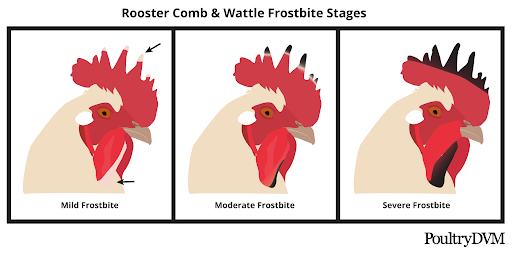
Preventing Frostnip and Frostbite
Choosing Cold Hardy Breeds
The first way to limit frostbite is to choose cold-hardy breeds of chickens if you live in a cold climate. Some most common breeds that do not mind cold winters are Orpingtons, Australorps, Silkie Bantams, Rhode Island Reds, New Hampshire Reds, Barred Rocks, Delawares, and Brahmas.
Insulating The Coop
Insulating your chicken coops will help make your chickens more comfortable, and happy, while significantly reducing their risk for frostbite during the winter. If you live in a cold climate it is recommended that you add sheets of insulation, use a spray foam insulation, or add a few layers of cardboard to your coop to prevent cold air drafts.
Chicken Coops and Insulation: We noticed that many chicken coops on the market are only made for having chickens seasonally, and they did not come with a floor. So we got to work creating a chicken coop that will meet all your needs and will last many years. Each of our chicken coops come with flooring and siding that has been treated with resin. In addition to insulation, our coops are designed for superior moisture resistance.
Ventilating the Coop
Chicken’s produce a lot of moisture through their breath and from their droppings, and when temperatures are low, that added moisture can contribute to an increased risk of frostbite. To prevent moisture from building up inside the coop, you will want to provide adequate ventilation and airflow. Ventilation should be provided through windows or vents that are towards the top of the coop and away from the roost or nesting boxes.
Chicken Coops and Ventilation: Our chicken coops are thoughtfully designed for your flock to endure the colder weather. In addition to screened windows, each of our coops are equipped with 2 vents on each gable end towards the upper point to let air flow through the coop.
Providing Additional Heat
Adding supplemental heat to the coop can help prevent your chickens from developing frostbite by combating moisture, the cold, or a combination of both. Check out our electrical heat package for a poultry safe way to warm up your coop.
Keep Bedding Dry and Clean
Lastly, you can prevent moisture and keep your chickens warm throughout harsh winters by making sure that their bedding is clean and dry. Removing wet, soiled litter and droppings helps keep moisture levels low, but if you find that you require a drier coop, you can try switching to pine shavings during the winter for bedding that remains warm and resists moisture.
Visit PoultryDVM for more information on how to spot frostbite warning signs in your flock, or to find veterinarians near you who specialize in poultry.
RELATED ARTICLES
Tips On Keeping Chickens Hydrated
Just like you, chickens need fresh, clean water to thrive. Follow these easy tips to quench your chicken's thirst so they can be healthy, strong, and egg-cellent layers.No Such Thing As “Too Much” Water For ChickensWhile a chicken will drink, on average, a pint a day,...
Solution To Five Chicken Feeding Problems
Feeding your chickens can be fun, but we are the first to admit, it can also be a pain. Cleaning out gunky feed, trying to hang your feeder, slogging through the rain or snow to top the feeder off before you leave for work... the list goes on and on! We have been...
Reasons Your Chickens Aren’t Laying Eggs
You know the routine - get up, get dressed, grab your coffee, and gather your morning eggs. But what happens when you walk out into the glistening morning, mug in hand and the nesting boxes are empty? Time for some troubleshooting. There are lots of reasons why your...

